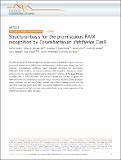| dc.contributor.author | Hirano, Seiichi | |
| dc.contributor.author | Abudayyeh, Omar O. | |
| dc.contributor.author | Gootenberg, Jonathan S | |
| dc.contributor.author | Horii, Takuro | |
| dc.contributor.author | Ishitani, Ryuichiro | |
| dc.contributor.author | Hatada, Izuho | |
| dc.contributor.author | Zhang, Feng | |
| dc.contributor.author | Nishimasu, Hiroshi | |
| dc.contributor.author | Nureki, Osamu | |
| dc.date.accessioned | 2019-11-08T21:59:25Z | |
| dc.date.available | 2019-11-08T21:59:25Z | |
| dc.date.issued | 2019-04 | |
| dc.date.submitted | 2019-03 | |
| dc.identifier.issn | 2041-1723 | |
| dc.identifier.uri | https://hdl.handle.net/1721.1/122813 | |
| dc.description.abstract | The RNA-guided DNA endonuclease Cas9 cleaves double-stranded DNA targets bearing a protospacer adjacent motif (PAM) and complementarity to an RNA guide. Unlike other Cas9 orthologs, Corynebacterium diphtheriae Cas9 (CdCas9) recognizes the promiscuous NNRHHHY PAM. However, the CdCas9-mediated PAM recognition mechanism remains unknown. Here, we report the crystal structure of CdCas9 in complex with the guide RNA and its target DNA at 2.9 Å resolution. The structure reveals that CdCas9 recognizes the NNRHHHY PAM via a combination of van der Waals interactions and base-specific hydrogen bonds. Moreover, we find that CdCas9 exhibits robust DNA cleavage activity with the optimal 22-nucleotide length guide RNAs. Our findings highlight the mechanistic diversity of the PAM recognition by Cas9 orthologs, and provide a basis for the further engineering of the CRISPR-Cas9 genome-editor nucleases. Keyword: DNA restriction-modification enzymes; X-ray crystallography | en_US |
| dc.description.sponsorship | National Institute of Mental Health (U.S.) (Grant 5DP1-MH100706) | en_US |
| dc.description.sponsorship | National Institute of Mental Health (U.S.) (Grant 1R01-MH110049) | |
| dc.language.iso | en | |
| dc.publisher | Springer Science and Business Media LLC | en_US |
| dc.relation.isversionof | http://dx.doi.org/10.1038/s41467-019-09741-6 | en_US |
| dc.rights | Creative Commons Attribution 4.0 International license | en_US |
| dc.rights.uri | https://creativecommons.org/licenses/by/4.0/ | en_US |
| dc.source | Nature | en_US |
| dc.title | Structural basis for the promiscuous PAM recognition by Corynebacterium diphtheriae Cas9 | en_US |
| dc.type | Article | en_US |
| dc.identifier.citation | Hirano, Seiichi, et al. "Structural basis for the promiscuous PAM recognition by Corynebacterium diphtheriae Cas9." Nature Communications 10, 1 (April 2019): 1968 © 2019 The Author(s) | en_US |
| dc.contributor.department | Massachusetts Institute of Technology. Department of Biological Engineering | en_US |
| dc.contributor.department | Massachusetts Institute of Technology. Department of Brain and Cognitive Sciences | en_US |
| dc.contributor.department | McGovern Institute for Brain Research at MIT | en_US |
| dc.relation.journal | Nature Communications | en_US |
| dc.eprint.version | Final published version | en_US |
| dc.type.uri | http://purl.org/eprint/type/JournalArticle | en_US |
| eprint.status | http://purl.org/eprint/status/PeerReviewed | en_US |
| dc.date.updated | 2019-10-08T13:25:14Z | |
| dspace.date.submission | 2019-10-08T13:25:19Z | |
| mit.journal.volume | 10 | en_US |
| mit.journal.issue | 1 | en_US |
